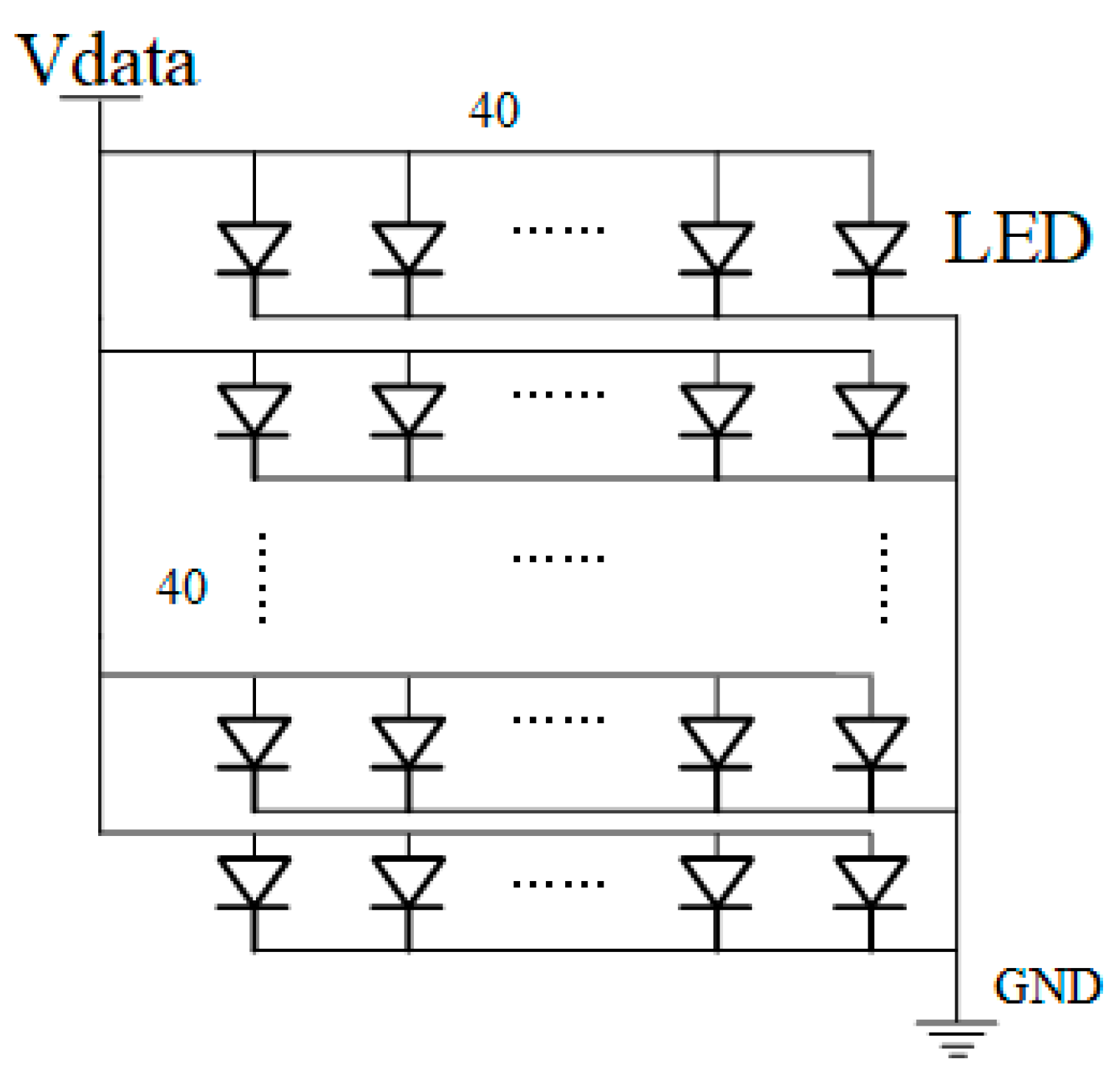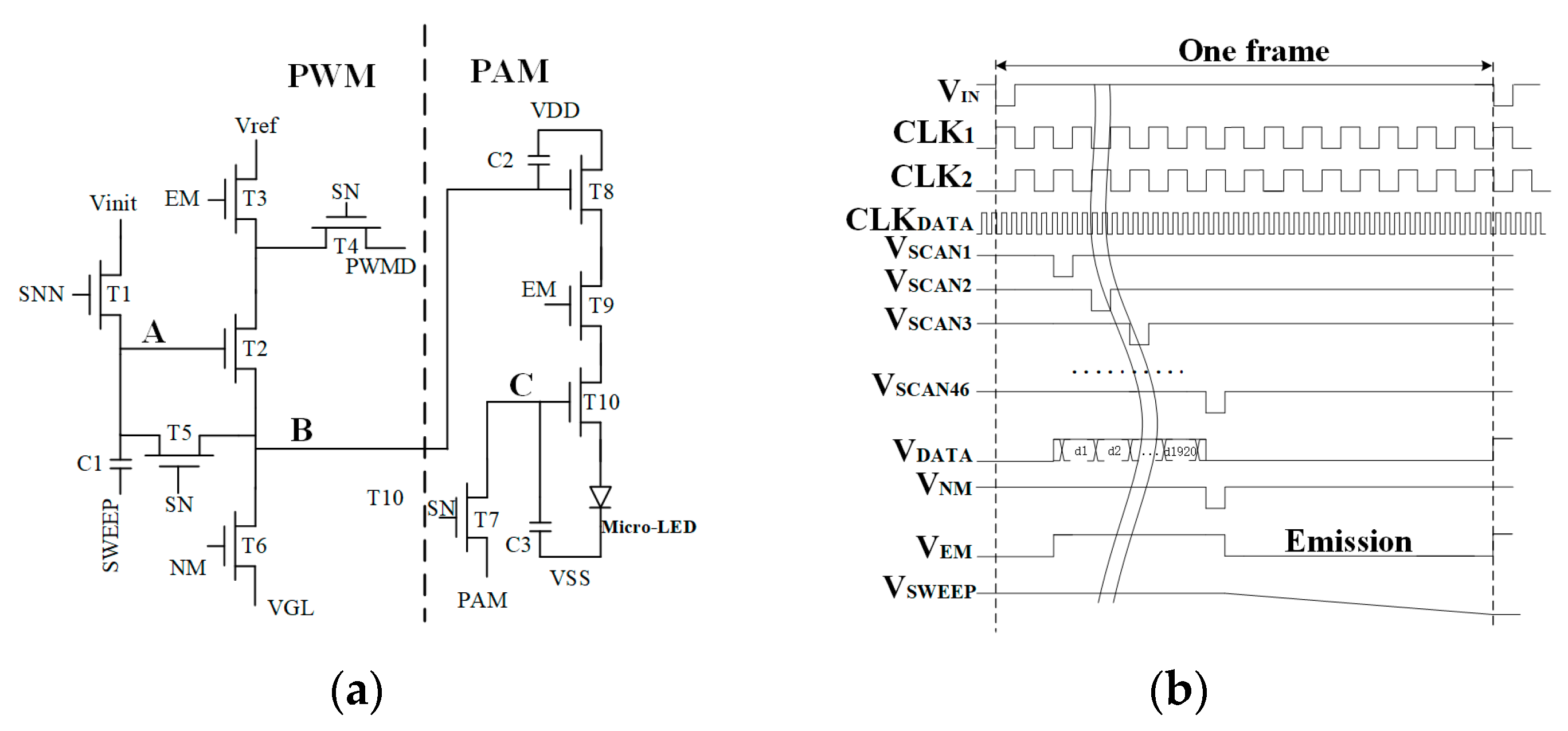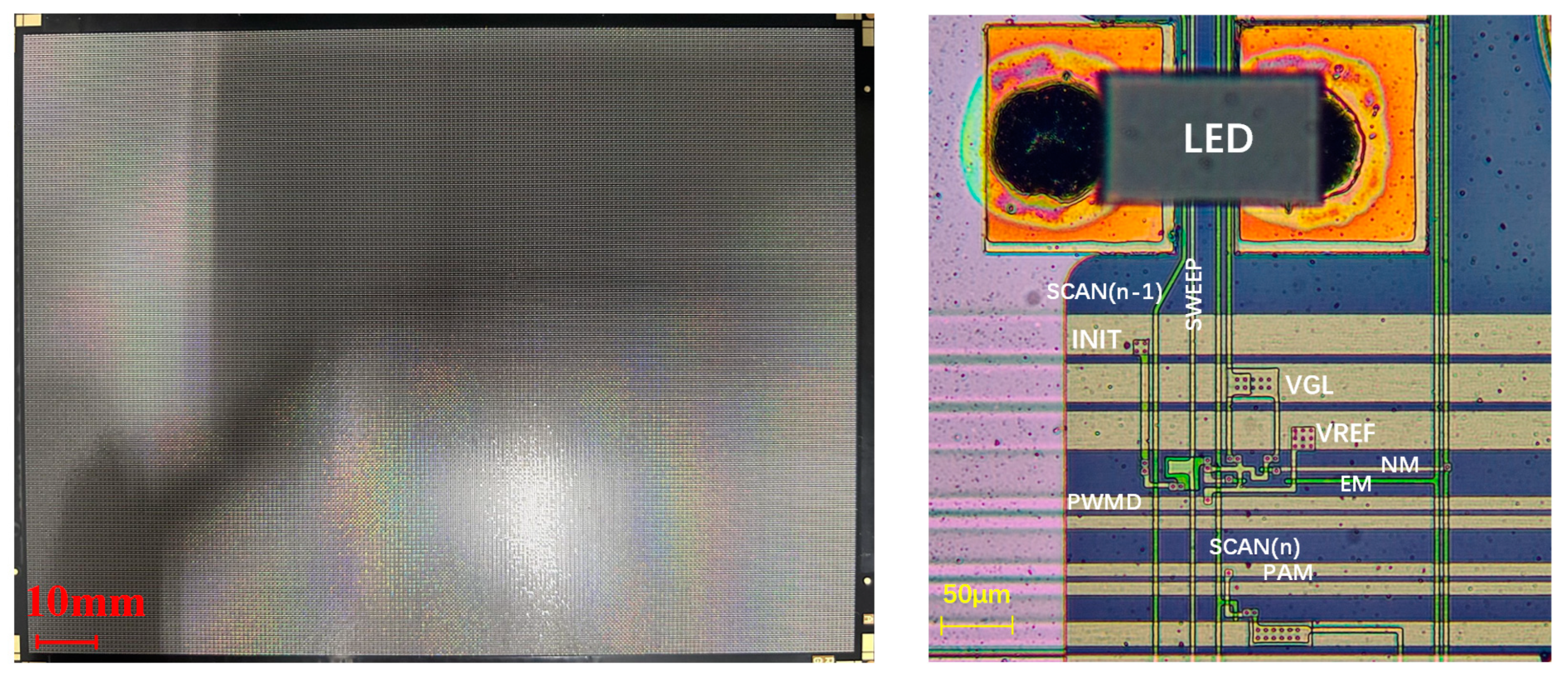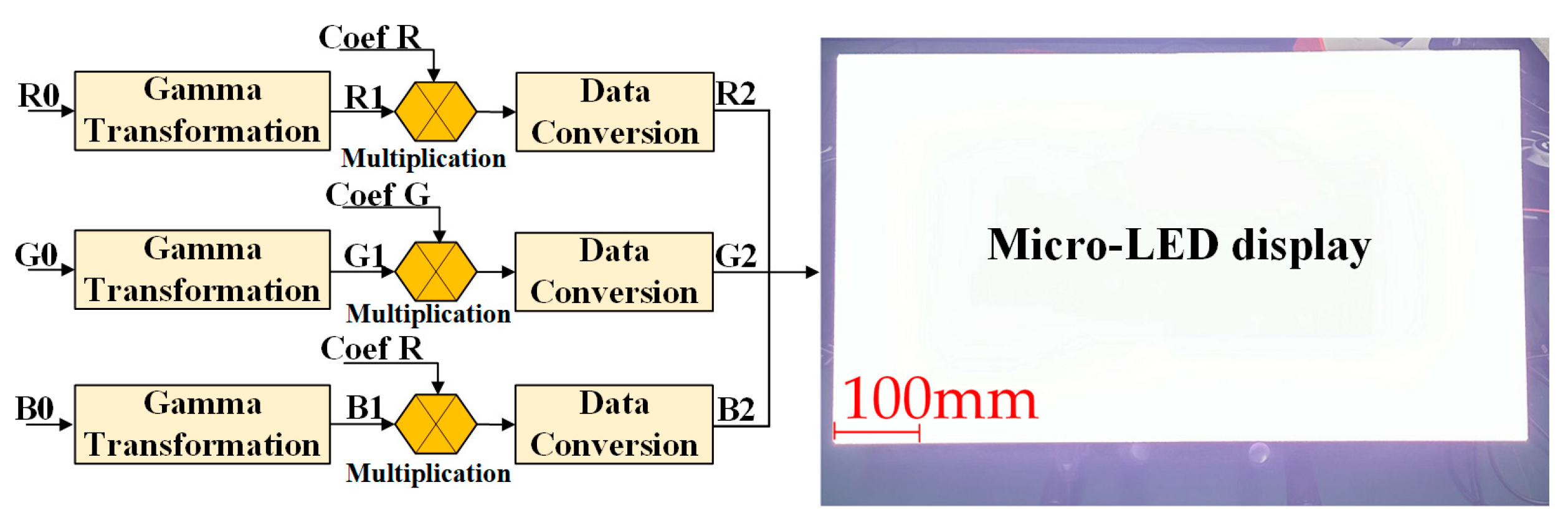Research on Characteristics Matching of Micro-LED Devices
Abstract
:1. Introduction
2. Methods
2.1. The Characteristics of Micro-LED
2.2. Preparation of Micro-LED Display Panel
3. Results
3.1. The Excessive Uniform Display in Greyscale
3.2. Uniform Brightness Display
4. Conclusions
Author Contributions
Funding
Data Availability Statement
Conflicts of Interest
References
- Chen, Z.; Yan, S.; Danesh, C. MicroLED technologies and applications: Characteristics, fabrication, progress, and challenges. J. Phys. D Appl. Phys. 2021, 54, 123001. [Google Scholar] [CrossRef]
- Huang, Y.; Hsiang, E.-L.; Deng, M.-Y.; Wu, S.-T. Mini-LED, Micro-LED and OLED display: Present status and future perspectives. Light Sci. Appl. 2020, 9, 105. [Google Scholar] [CrossRef] [PubMed]
- Lin, J.Y.; Jiang, H.X. Development of Micro-LED. Appl. Phys. Lett. 2020, 116, 100502. [Google Scholar] [CrossRef]
- Wu, T.; Sher, C.-W.; Lin, Y.; Lee, C.-F.; Liang, S.; Lu, Y.; Chen, S.-W.H.; Guo, W.; Kuo, H.-C.; Chen, Z. Mini-LED and micro-LED: Promising candidates for the next generation display technology. Appl. Sci. 2018, 8, 1557. [Google Scholar] [CrossRef]
- Chang, K.-P.; Lien, P.-C.; Yen, C.-C.; Chen, P.-W.; Horng, R.-H.; Wuu, D.-S. High performance AlGaInP-based micro-LED display with novel pixel structures. IEEE Photon. Technol. Lett. 2021, 33, 1375–1378. [Google Scholar] [CrossRef]
- Chen, G.; Craven, M.; Kim, A.; Munkholm, A.; Watanabe, S.; Camras, M.; Götz, W.; Steranka, F. Performance of high-power III-nitride light emitting diodes. Phys. Status Solidi A 2008, 205, 1086–1092. [Google Scholar] [CrossRef]
- Kim, J.-H.; Shin, S.; Kang, K.; Jung, C.; Jung, Y.; Shigeta, T.; Park, S.-Y.; Lee, H.S.; Min, J.; Oh, J.; et al. 15-1: PWM Pixel Circuit with LTPS TFTs for Micro-LED Display. SID Symp. Dig. Tech. Pap. 2019, 50, 192–195. [Google Scholar] [CrossRef]
- Oh, J.; Kim, J.-H.; Lee, J.; Jung, E.K.; Oh, D.; Min, J.; Im, H.; Kim, Y.-S. Pixel Circuit with P-Type Low-Temperature Polycrystalline Silicon Thin-Film Transistor for Micro Light-Emitting Diode Display Using Pulse width Modulation. IEEE Electron Device Lett. 2021, 42, 1496–1499. [Google Scholar] [CrossRef]
- Zou, P.-A.; Xu, Y.-G.; Liu, C.; Zhang, L.-R.; Zhang, J.-H.; Yuan, Y.-K.; Cai, W.; Han, S.-H.; Zhou, L.; Xu, M.; et al. A New Analog PWM Pixel Circuit with Metal Oxide TFTs for Micro-LED display. IEEE Trans. Electron Devices 2022, 69, 4306–4311. [Google Scholar] [CrossRef]
- Li, S.; Wu, W.; Chen, C.; Chuai, X.; Zhang, C.; Gu, C.; Liu, Y.; Lu, N.; Geng, D.; Li, L. Novel A-IGZO TFT Pixel Driving Circuit Using Hybrid PWM and PAM Method With Lower Power Consumption for Micro-LED Display. IEEE Electron Device Lett. 2024, 45, 1024–1027. [Google Scholar] [CrossRef]
- Xiao, J.; Huo, W.; Yuan, D.; Liang, C.; Lai, G.; Li, J.; Xu, H.; Li, S.; Zhang, S. A New Pixel Circuit for Micro-Light Emitting Diode Display With Pulse Hybrid Modulation Driving and Compensation. IEEE J. Electron Devices Soc. 2023, 12, 1–6. [Google Scholar] [CrossRef]
- Lin, Y.-Z.; Liu, C.; Zhang, J.-H.; Yuan, Y.-K.; Cai, W.; Zhou, L.; Xu, M.; Wang, L.; Wu, W.-J.; Peng, J.-B. Active-Matrix Micro-LED display Driven by Metal Oxide TFTs Using Digital PWM Method. IEEE Trans. Electron Devices 2021, 68, 5656–5661. [Google Scholar] [CrossRef]
- Sohn, Y.; Moon, G.; Choi, K.; Kim, Y.; Park, K. Effects of TFT Mobility Variation in the Threshold Voltage Compensation Circuit of the OLED Display. J. Inf. Disp. 2016, 18, 25–30. [Google Scholar] [CrossRef]
- Hong, Y.-H.; Jung, E.K.; Hong, S.; Kim, Y.-S. 61-2: A Novel Micro-LED Pixel Circuit Using N-type LTPS TFT with Pulse Width Modulation Driving. SID Symp. Dig. Tech. Pap. 2021, 52, 868–871. [Google Scholar] [CrossRef]
- Li, Y.; Tao, J.; Zhao, Y.; Wang, J.; Lv, J.; Qin, Y.; Liang, J.; Wang, W. 48 × 48 pixelated addressable full-color micro display based on flip-chip micro LEDs. Appl. Opt. 2019, 58, 8383–8389. [Google Scholar] [CrossRef] [PubMed]
- Li, Y.; Tao, J.; Wang, Q.; Zhao, Y.; Sun, Y.; Li, P.; Lv, J.; Qin, Y.; Wang, W.; Zeng, Q.; et al. Microfluidics-based quantum dot color conversion layers for full-color micro-LED display. Appl. Phys. Lett. 2021, 118, 173501. [Google Scholar] [CrossRef]
- Zhao, X.; Wang, R.; Zheng, X.; Hao, Y.; Chen, Y. Systemic Accuracy Analysis of LED Display Based on Visual Perception. Chin. J. Liq. Cryst. Disp. 2012, 27, 324–331. [Google Scholar] [CrossRef]
- Huang, S.; Zheng, X.; Mao, X.; Chen, Y.; Chen, Y. Vignetting Compensation Method for CMOS Camera Based on LED Spatial Array. Electronics 2024, 13, 1936. [Google Scholar] [CrossRef]
- Chen, Y.; Zheng, X.; Cao, H.; Wang, Y.; Cheng, H.; Chen, J.; Huang, S.; Li, J.; Huang, D.; Chen, Y. High Precision Control System for Micro-LED Display. Appl. Sci. 2023, 13, 10601. [Google Scholar] [CrossRef]
- ICDM Display Metrology Standard. Available online: https://www.icdm-sid.org/ (accessed on 22 April 2024).












| Maximum Target Luminance (cd/m2) | Minimum Target Luminance (cd/m2) | |
|---|---|---|
| White | 1000 | 0.010 |
| Red | 300 | 0.003 |
| Green | 600 | 0.006 |
| Blue | 100 | 0.001 |
| Luminance of Sample (cd/m2) | Target Luminance (cd/m2) | |||
|---|---|---|---|---|
| Max | Min | Max | Min | |
| Red | 312 | 0.0030 | 300 | 0.003 |
| Green | 580 | 0.0060 | 600 | 0.006 |
| Blue | 97 | 0.0018 | 100 | 0.001 |
| Applied Vdata for Maximum Luminance (V) | Applied Vdata for Minimum Luminance (V) | |
|---|---|---|
| Red | 1.67 | 1.36 |
| Green | 2.08 | 1.79 |
| Blue | 2.42 | 2.12 |
| Maximum Luminance (cd/m2) | Panel Current (mA) | Single LED Current (μA) | |
|---|---|---|---|
| Red | 312 | 14 | 8.7 |
| Green | 580 | 3 | 1.8 |
| Blue | 97 | 4 | 2.5 |
| Red | Green | Blue | |
|---|---|---|---|
| Grey depth (bits) | 11 | 12 | 10 |
| Position | 1 | 2 | 3 | 4 | 5 | 6 | 7 | 8 | 9 | |
|---|---|---|---|---|---|---|---|---|---|---|
| 1 | 601 | 700 | 630 | 641 | 635 | 546 | 565 | 571 | 553 | 84.2% |
| 2 | 603 | 583 | 586 | 546 | 568 | 542 | 586 | 570 | 673 | 84.7% |
| 3 | 597 | 682 | 603 | 563 | 564 | 545 | 599 | 569 | 597 | 84.6% |
| 4 | 596 | 601 | 689 | 553 | 612 | 535 | 589 | 568 | 613 | 84.2% |
| 84.4% |
| Position | 1 | 2 | 3 | 4 | 5 | 6 | 7 | 8 | 9 | |
|---|---|---|---|---|---|---|---|---|---|---|
| 1 | 581 | 600 | 601 | 598 | 583 | 589 | 575 | 571 | 583 | 97.3% |
| 2 | 580 | 599 | 600 | 597 | 583 | 589 | 571 | 570 | 582 | 97.3% |
| 3 | 581 | 598 | 598 | 597 | 583 | 589 | 574 | 569 | 582 | 97.1% |
| 4 | 580 | 597 | 599 | 597 | 581 | 587 | 574 | 568 | 582 | 97.0% |
| 97.1% |
Disclaimer/Publisher’s Note: The statements, opinions and data contained in all publications are solely those of the individual author(s) and contributor(s) and not of MDPI and/or the editor(s). MDPI and/or the editor(s) disclaim responsibility for any injury to people or property resulting from any ideas, methods, instructions or products referred to in the content. |
© 2024 by the authors. Licensee MDPI, Basel, Switzerland. This article is an open access article distributed under the terms and conditions of the Creative Commons Attribution (CC BY) license (https://creativecommons.org/licenses/by/4.0/).
Share and Cite
Chen, Y.; Zheng, X.; Mao, X.; Cao, H.; Wang, Y.; Xu, Z.; Chen, J.; Liu, F.; Huang, D.; Chen, Y. Research on Characteristics Matching of Micro-LED Devices. Electronics 2024, 13, 3369. https://doi.org/10.3390/electronics13173369
Chen Y, Zheng X, Mao X, Cao H, Wang Y, Xu Z, Chen J, Liu F, Huang D, Chen Y. Research on Characteristics Matching of Micro-LED Devices. Electronics. 2024; 13(17):3369. https://doi.org/10.3390/electronics13173369
Chicago/Turabian StyleChen, Yufeng, Xifeng Zheng, Xinyue Mao, Hui Cao, Yang Wang, Zicheng Xu, Junchang Chen, Fengxia Liu, Deju Huang, and Yu Chen. 2024. "Research on Characteristics Matching of Micro-LED Devices" Electronics 13, no. 17: 3369. https://doi.org/10.3390/electronics13173369






